After a disappointing 21/22 campaign, VfL Wolfsburg moved quickly to appoint Niko Kovac as the man to take over from Florian Kohfeldt. The Green-and-Whites have appointed the former Bayern Munich and Eintracht Frankfurt head coach on a three-year deal until 2025.
The Berlin-born manager, who is Croatian through his family, is returning to the Bundesliga after a stint in France with Ligue 1 side Monaco.
Although he was sacked in January after falling out with sporting director Paul Mitchell, his spell at the Stade Louis II was considered a success. In his first and only full season in charge, he took them from being relegation candidates to title contenders by finishing third with a 63%-win rate.
However, his biggest achievements have come as a Bundesliga coach, where he won the league and cup double with Bayern Munich in the 2018/19 season as well as the DFB Cup victory with Eintracht Frankfurt in 2018.
This article will be a tactical analysis of Niko Kovac’s tactics and style of play. We will focus on his attacking and defensive tactics and provide an insight into the tactical trends the Wolfsburg fans can expect to see at the Volkswagen Arena this coming season.
Formation
Niko Kovac is a coach who has shown a lot of flexibility with the formations he chooses to implement. He is a tactically astute manager who coaches his teams to be able to fluidly change formation in-game and between matches. You can see from the data below how many different formations the former Croatian international has used in each of his full seasons in charge.
When he was in charge of Eintracht Frankfurt, he built his tactical approach from a three-man defence. The graph below shows his main formation was a 3-5-2, but Kovac’s in-game tactics saw Frankfurt switch between a 3-4-1-2 and a 3-1-4-2 formation as this suited the more counterattacking approach he used at the club.
Frankfurt 2017-2018
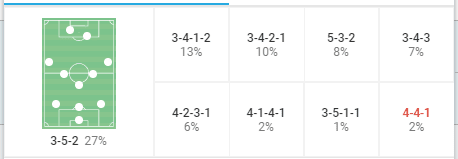
At Bayern Munich, the 4-2-3-1 was preferred because of the playing squad he had available. He couldn’t look to set up with a 3-5-2 as Robert Lewandowski was the only recognised striker at the club and the importance and influence of Thomas Muller meant that he couldn’t be left out. Given Muller’s positional limitations in any formation other than a 4-2-3-1, it had to be that formation to get the best of that squad.
Bayern 2018/2019
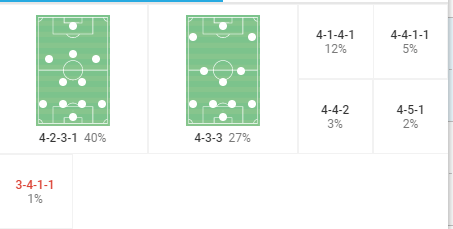
Monaco provided Kovac with the best opportunity to be flexible within his approach. The players he had at his disposal allowed him to switch between more formations. The physicality of the players allowed him to be able to set up his stem to suit the defensive needs of the team and the balance of the squad allowed him more variety in how he wanted them to impose themselves in possession as they looked to control the game more through keeping possession.
Monaco 2020/2021

Defensive Principles
As a coach, his teams have always been defensively solid and hard to play through. Although his formations may vary, Kovac’s defensive principles remain the same. He wants his teams to play on the front foot out of possession as well as in possession.
His teams place huge importance on having defensive stability within his block. The type of block that Kovac instructs depends on the formation, and the team is coached to play all three within the same game. As switching between defensive blocks is better suited to the aggressive man-orientated pressing structure that Kovac applies to his approach.
Whether it be Frankfurt Bayern Munich or Monaco his teams will always look to protect the centre of the pitch with a compact midfield and force the opposition out wide. Kovac allows his teams to concede space in the wide areas to attract the opposition to play down each side, with the focus being to win the ball out wide.
When either of his teams utilises a four-man defence, their defensive block will vary depending on what area of the pitch the opposition holds possession of the ball. Here, Monaco are sitting in a low block as Rennes have the ball out wide in Monaco’s defensive third. Monaco are sitting in a 4-4-1-1 narrow and compact defensive shape. There is little space between the lines and because of how narrow the midfield are positioned, Rennes have no choice but to play down the right channel.
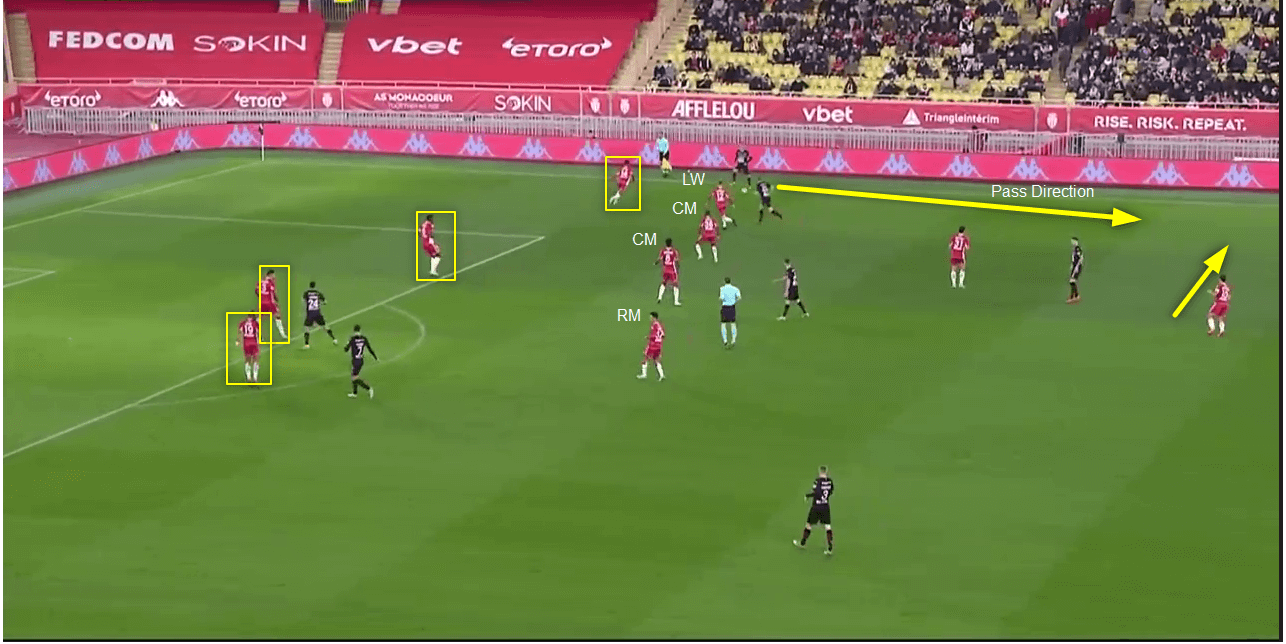
It is at this point Monaco’s defensive block looks to force Rennes back towards their half. Then Monaco centre forward Wissam Ben Yedder will close down the channel and aim to force Rennes to play the ball back to their goalkeeper. Forcing the opponents back in this manner is what makes a defensive block successful if the ball can’t be won.
When the opposition has possession in the middle third and through the centre of the pitch, you can see how the attacking midfielder drops in into the midfielder for extra protection centrally, like in the image below.
This allows the other midfielders to form a double-pivot and the team to switch to a 4-2-3-1 defensive shape with the wide players coming inside to join them, causing the team to stay narrow and keep their compactness.
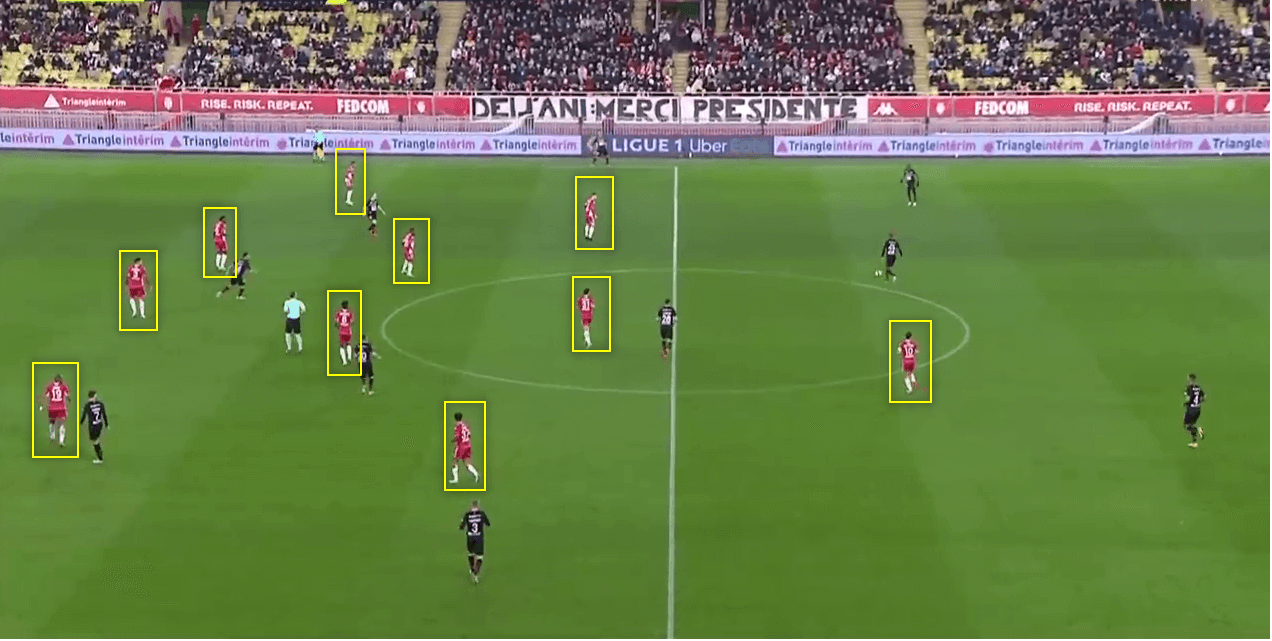
You can see how little space Rennes have available to be able to progress the ball through the middle of the pitch, as Monaco’s defensive shape blocks any central passing lanes. The only option Rennes have is to play the ball out wide. Which then triggers Monaco press to win the ball.
When the opposition is building up through their defence Niko Kovac changes how his team’s press, depending on the formation they are playing within that match.
If they are playing with a formation that has a four-man defence like below, they will transition into a 4-1-4-1 defensive shape when they defend with a high block. The man-orientated pressing structure remains, as the team will look to keep their shape look to stop central ball progression.
The image below is how, when playing under Kovac, Monaco’s midfield moves forward a couple of yards whilst Ben Yedder closes the ball down. Instead of the right winger Sofiane Diop pushing forward to make the attacking line a front two, he holds his position to keep the team’s shape.
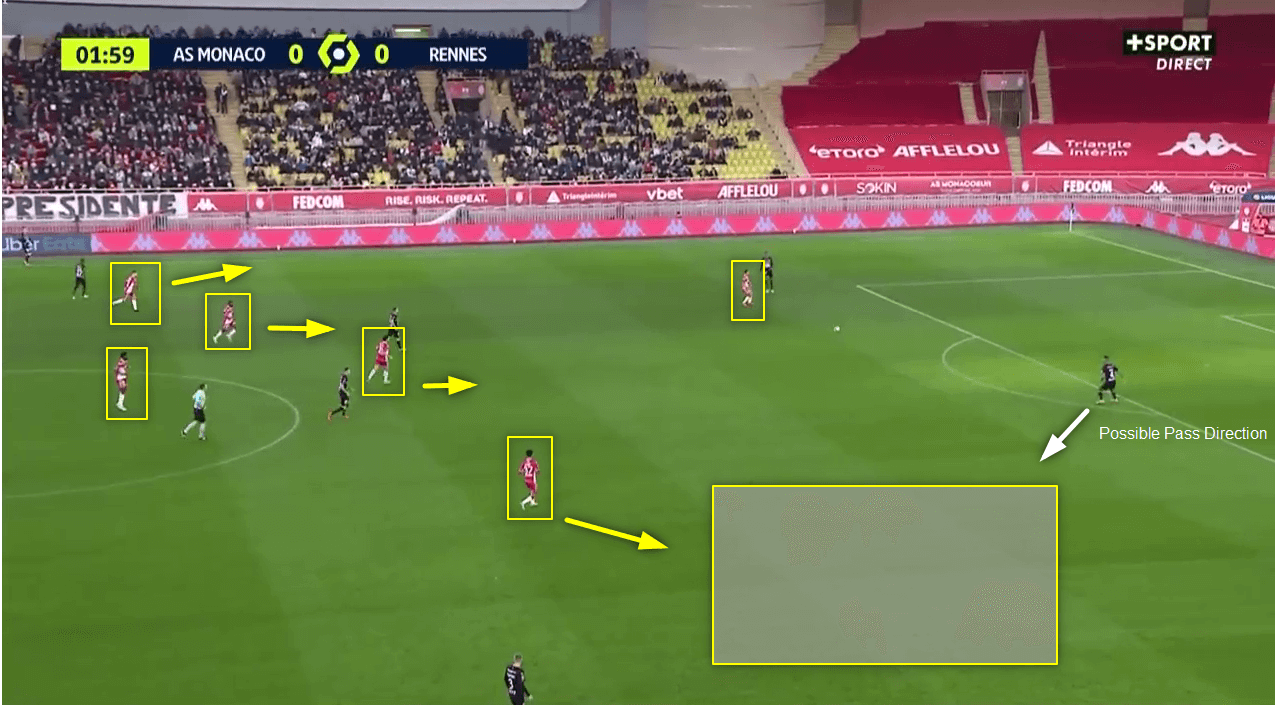
When defending high up the pitch in this way, the aim is not to force the opposition out wide or backwards, it is to force them into long balls and to concede possession.
When playing with a three-man defensive line, his Monaco and Frankfurt teams pressed higher up the pitch. The pressing structure changed to a ball-orientated press with a tight man-marking system. So, there is a lot less emphasis on keeping a defensive shape and more importance placed on winning the ball back. However, when Monaco and Frankfurt were applying this press under Kovac, both backlines switched from a back three to a back four behind the pressing wing-back. The extra support gives more defensive coverage if their press was to get beat. This provides maximum structure and security behind a high-risk man-oriented press.
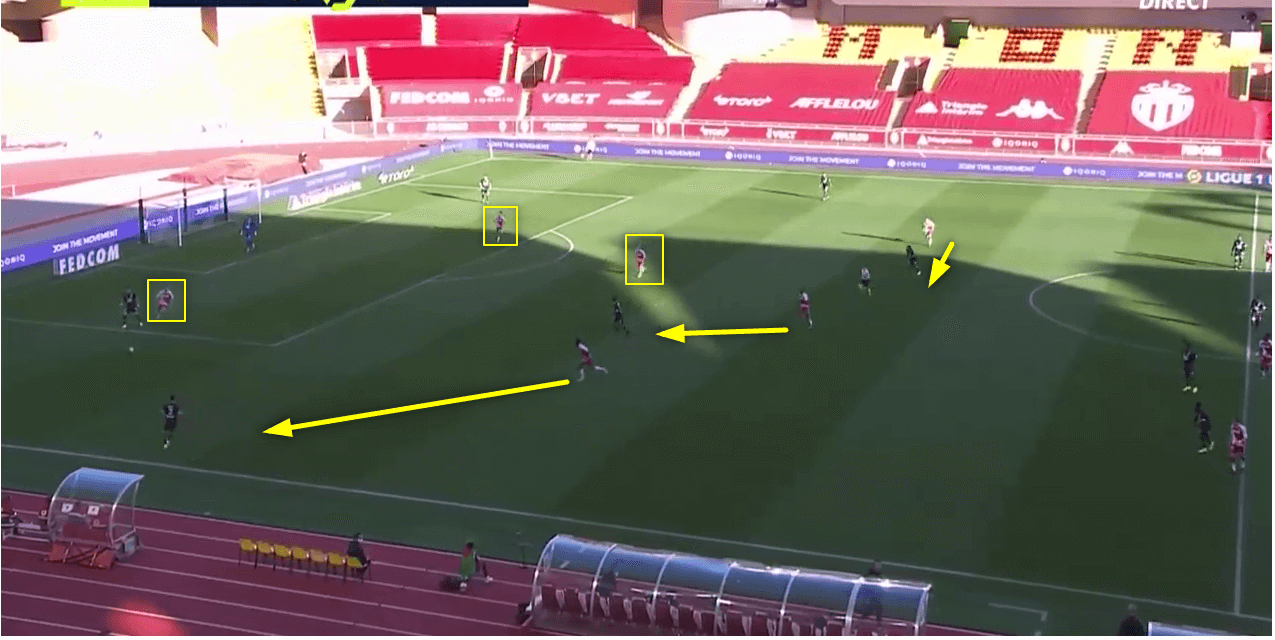
Overall Kovac has had success at every club he has coached when making his team defensively efficient. Naturally, Bayern Munich, due to the quality of players and the level they hold within the Bundesliga will always show a high rating when measuring the statistics of each team.
However, in the full season that he managed Frankfurt, the club finished third in Bundesliga for the number of passes per defensive action (PPDA) they allowed their opponents to make before engaging them. They finished in the top five for the least number of shots they conceded and the amount interceptions they made per game, averaging 11.7pg, and 12pg.
His Monaco team were even more impressive defensively. They topped the table for several defensive metrics when looking at the side’s data during his only full season in charge.
- Least number of shots conceded per game – 1st. 8.6 per game
- Challenge Intensity (Duels, tackles, and interceptions attempted per minute of opponent possession) – 1st. 6.4 per game
- Highest defensive dual success rate – 1st. 63.8%
- Passes per defensive action (PPDA) – 2nd. 10.58 per game
It will be interesting what defensive set-up Niko Kovac looks to instil at Wolfsburg this season. The team’s defensive shape will be at the forefront of his decision when choosing his formation. Last season, the team set up in 3-4-2-1 as their main formation and a 4-2-3-1 formation as their alternative. We believe Kovac will look to play with a three-man defence. In Maxence Lacroix, Sebastiaan Bornauw and Marin Pongracic, they have solid options at centre-back to play the three and this will also allow Ridle Baku and Jérôme Roussillon to play as wingbacks, which will help Wolfsburg’s attack.
Attacking Principles.
Even though the possession game his teams play is structured, Kovac does allow more variety to his side’s attacking approach. He has adapted his attacking style at each of the clubs he has managed which is a credit to his adaptability as a coach.
During his spells in charge at Eintracht Frankfurt and Monaco, his in-possession approach differed. The attacking tactics he deployed at Frankfurt focused on quick transitions from defence to attack. The team was set up to counterattack and get the ball into the opposition’s third as much as possible. At Monaco, his teams kept a higher amount of possession, with an emphasis on positional play. Monaco still played with vertical progression, but they looked to play through each third of the pitch more, aiming to create numerical superiority in each phase.
Although the tactics he looks to implement during the attacking phase are based on the players he has at his disposal, when you watch each of his teams play, you can see similarities within their attacking trends.
His approach relies on off-the-ball movement and interchanging positions too. Movement is pivotal in how he wants his teams to attack, which is predominantly through the left and right channels.
Niko Kovac’s preferable build-up play is to play through the defence from goal kicks. At Frankfurt, the build-up from the goalkeeper was varied, as he would look to go long into the wide areas as well as play out through the centre-backs. At Bayern Munich and Monaco, the set-up during this phase of play was to always play through the defence unless specific circumstances dictated otherwise.
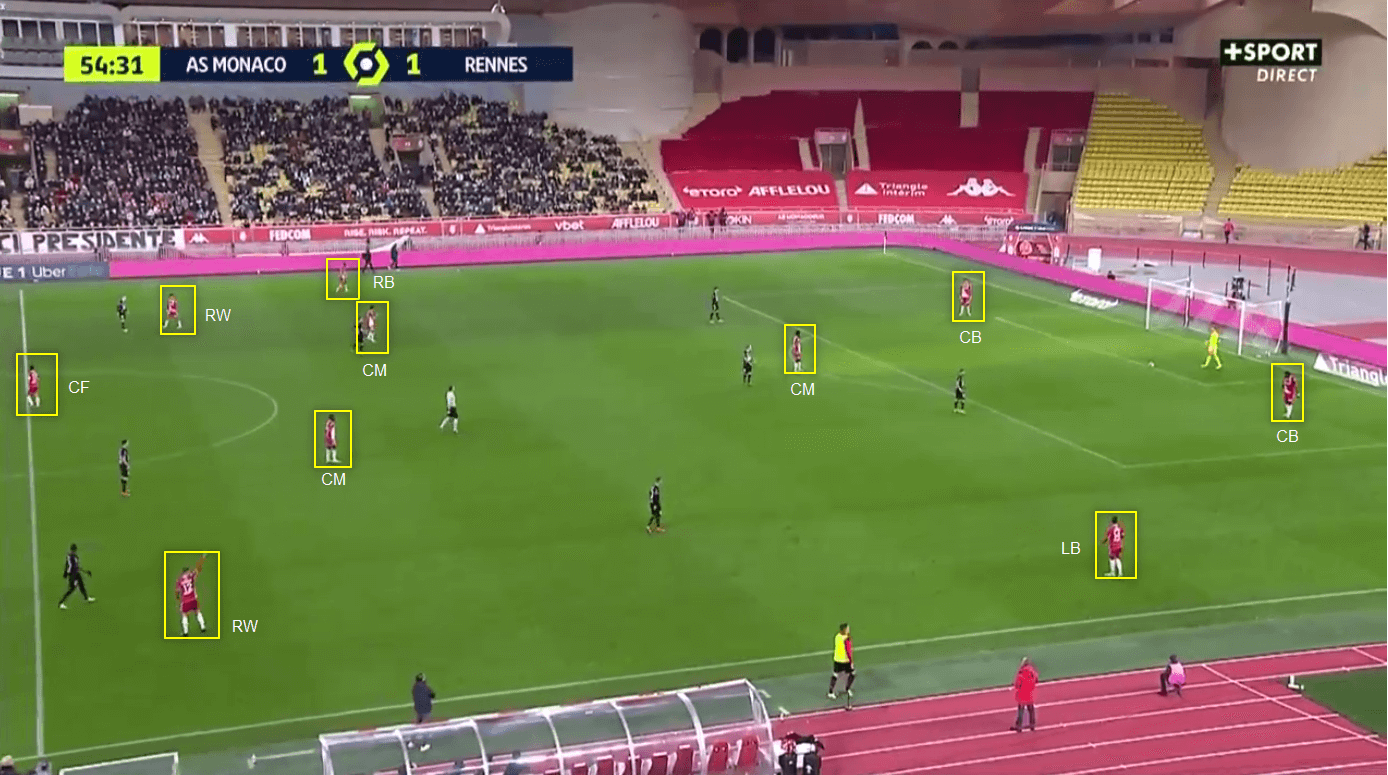
When the play is progressed, and the team move higher up the pitch, this is where the team’s transition into an attacking shape starts to take place. At Monaco, his team would transition into a 3-2-4-1 or 3-1-6 attacking shape, no matter what formation they played through the game.
Building with either of these two shapes allowed Monaco to achieve a 3v2 numerical superiority against the opposition’s first line of pressure during the build-up. By spreading themselves out, it created a greater area for the opponents to cover during their press and inevitably made it more difficult. The 3-2-5 allows the team to get players between each set of lines in their defensive shape.
The image below shows how Monaco has two sets of two players between both the Rennes attack and midfield and the midfield and defence. This provides a greater opportunity for vertical progression and allows greater opportunities to pull the opposition from their defensive shape as you move the ball, which is a principle of positional play.
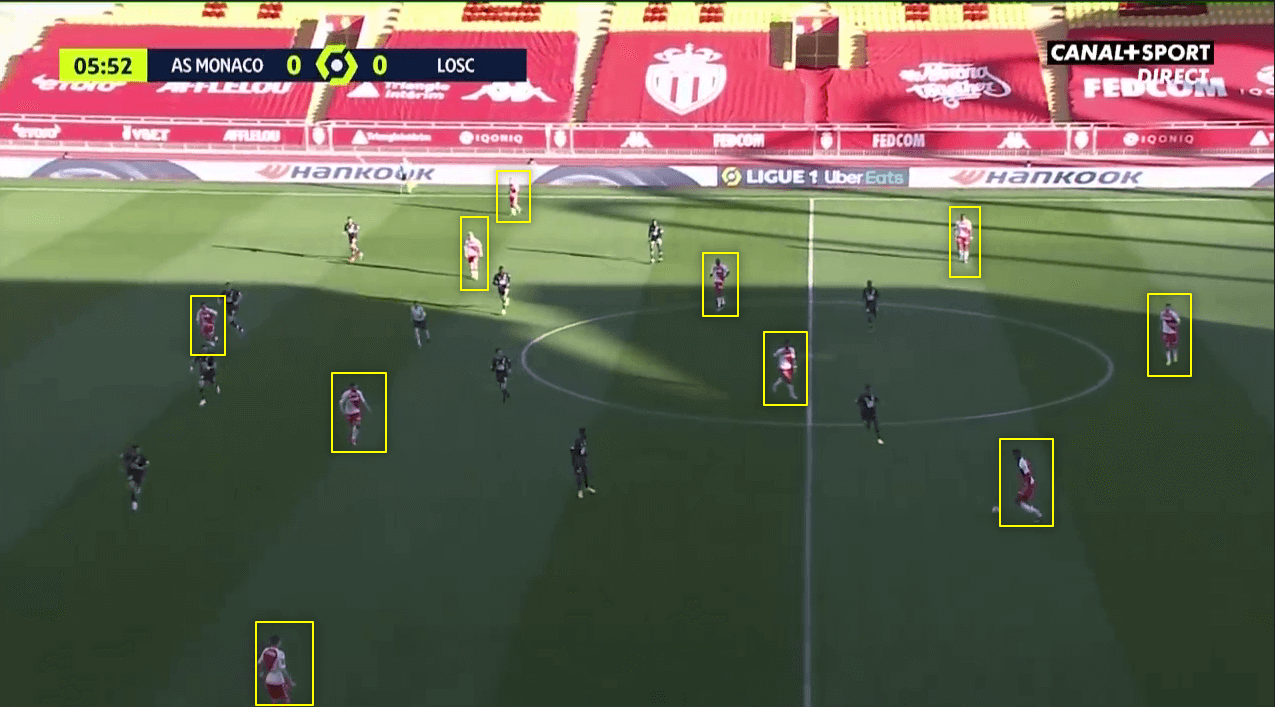
The 3-1-6 allows the central midfielders to push up into the attacking and attempt to control the half-spaces. It also allows the team to create an attacking line that gives them full coverage of the pitch horizontally and gives the team the opportunity to overload the pitch in the wide areas, which is a specific focus within Niko Kovac’s tactics.
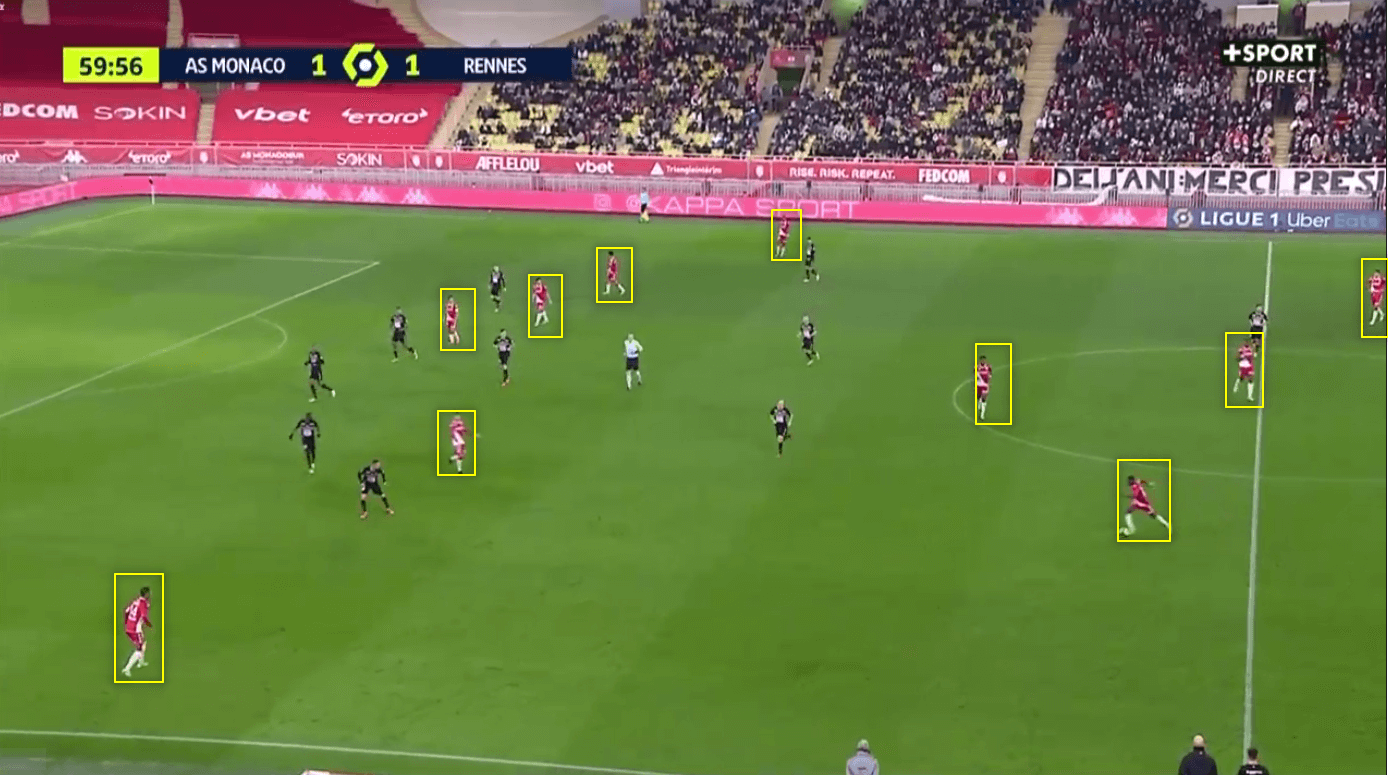
Creating overloads in wide areas and penetrating the opponent’s defence with crosses and runs in behind is how Kovac wants his team to win football matches. The image below shows how his Monaco team are all positioned in the opposition’s half as they dictate the play.
They have created an overload down the left-hand side. The left-back has pushed high alongside the left winger which drags Rennes’s right back and right-winger further out wide to try and block any progression towards them. The central midfielder has pushed up into the half-space to become the third man. His position in the half-space creates the 3v2 and attracts Rennes to move over to that side as Monaco plays down the left flank.
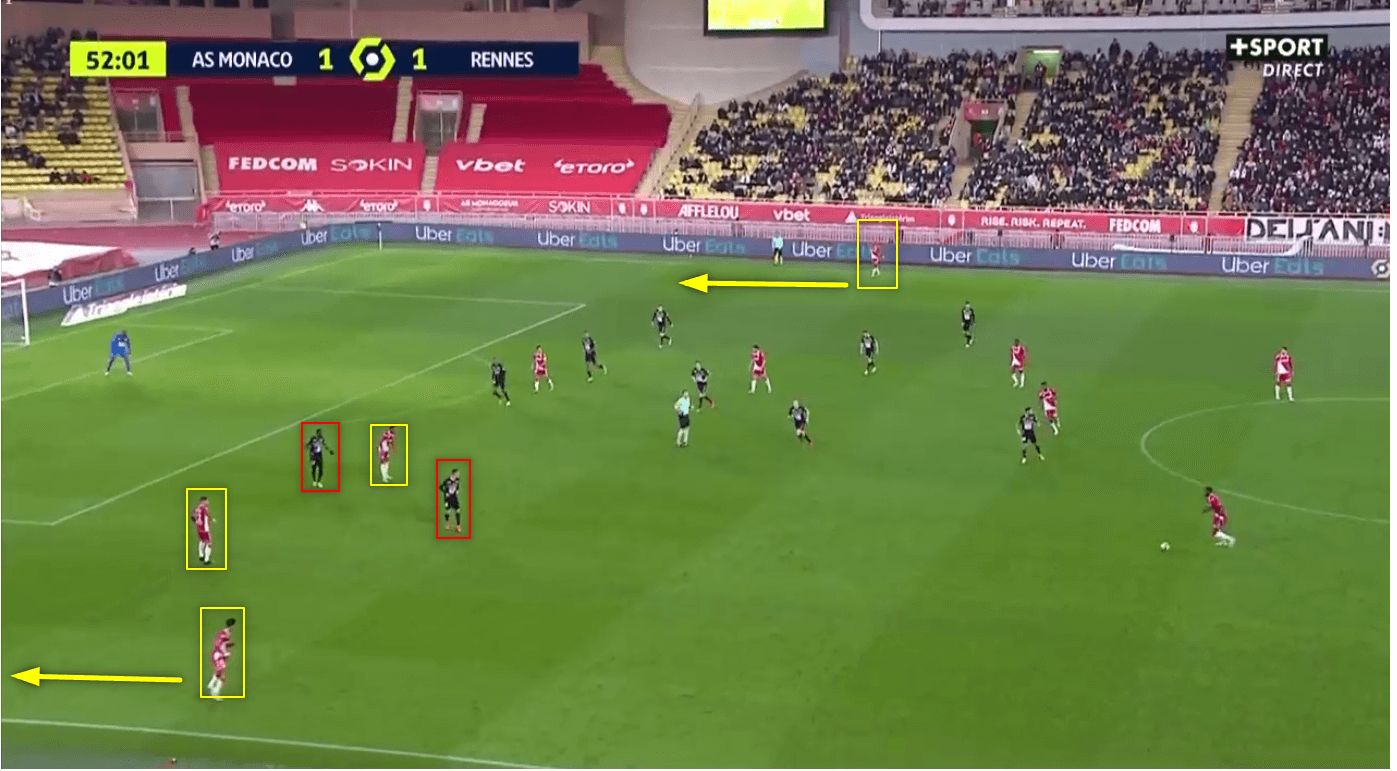
You can see how Monaco’s right back, Djibril Sidibe, has pushed just as high up the right-hand side. This is because the overload on the left creates more space on the right to attack.
Therefore, Kovac places high importance on attacking through the wide areas with these patterns so his teams create more space to attack when they cross into the penalty area.
Part of the reason we believe he will start this season at Wolfsburg with a three-man defence is partly down to the attack. Kovac will have to find a way to fit both Max Kruse and Max Phillip into the team. Neither player are their best when they are not playing centrally. Kruse can be used up front but operates best playing off a striker. Deploying both him and Phillip behind a striker in a 3-4-2-1 would suit the tactics and attacking approach that Kovac likes to play with.
Conclusion
Niko Kovac is Wolfsburg’s third managerial appointment in just over a year. It is fair to say that the team underperformed last season as they finished in a hugely disappointing 12th, after having qualified for the Champions League in the previous campaign under Oliver Glasner.
After the appointments of Mark Van Bommel and Florian Kohfeldt didn’t work out, Die Wölfe appointing Niko Kovac is very clever and, based on his achievements at Eintracht Frankfurt, Bayern, and Monaco, it could be sighted as a coup for the Lower Saxony club.
Given the way he was dismissed by Monaco, both he and the club have a point to prove going into next season, giving the VfL fans reason to be optimistic about the forthcoming campaign.
This analysis has broken down the tactics that Niko Kovac has implemented throughout his career. The article highlights the key principles of Kovac’s attacking and defensive structure and shows what the former Croatia coach could look to implement at Wolfsburg this season.






Comments